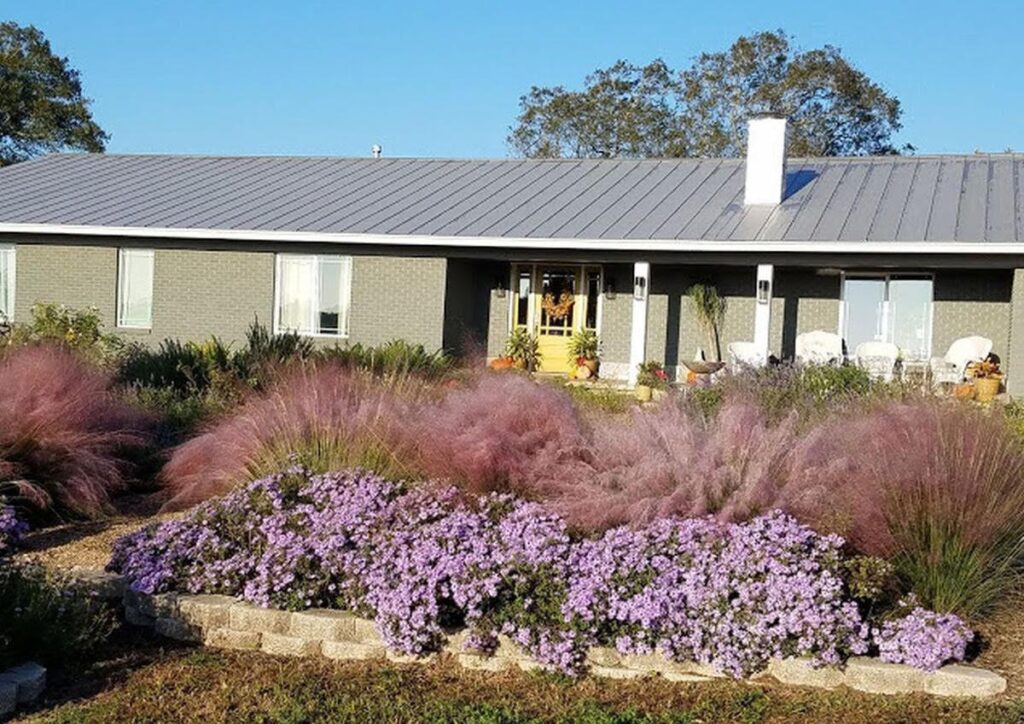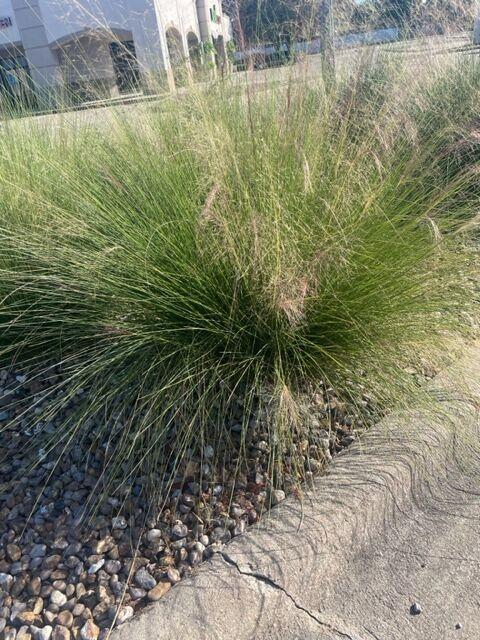ELEGANT GRASSES: Muhly grasses-new additions for hot weather landscaping
Gardeners’ Dirt for October 7, 2023 by Victoria County Master Gardener Betty Tovar

CONTRIBUTED PHOTO BY ANNABETH NEUMEYER — Gulf Muhly in bloom

CONTRIBUTED PHOTO BY JOHN FOSSATI — Gulf Muhly grass begins to bloom now.

CONTRIBUTED PHOTO FROM TEXAS SUPERSTAR PHOTO BANK — Lindheimer Muhly

CONTRIBUTED PHOTO BY VICTORIA COUNTY MASTER GARDENER BETTY TOVAR — Native grasses at Victoria Educational Gardens
If you are like me, this summer’s record heat may have you rethinking your landscape choices. Two ornamental grasses that you might consider adding to your garden are gulf muhly (Muhlenbergia capillaris) and Lindheimer mMuhly (Muhlenbergia lindheimeri).
Both have been named Texas Superstar plants (texassuperstar.com/) and deemed ‘Texas tough’ by the Texas A&M AgriLife Research Department. Muhly grasses belong to the grass family Poaceae, and are beautiful native perennial bunchgrasses. They are drought tolerant, relatively disease resistant, easy to grow, and deer tend to leave them alone.
The grasses take their name in part from Gotthilf (Henry) Muhlenberg (1753-1815), who was born in Pennsylvania. Due to his family’s involvement in the Revolutionary War, he was on a British hit list.
Muhlenberg became interested in botany while hiding out in a rural area outside of Philadelphia. It was the beginning of his extensive collection of plants that led to many that are named in his honor, including several species of muhly grasses.
Gulf muhly, also known as hairy-awn muhly or pink muhly, can be found in its native habitat along the Gulf Coast. It can also be found on the eastern edge of the Edwards Plateau and parts of Southeast Texas. It usually reaches 1-1/2 to 3 feet tall and wide and has glossy deep green leaves.
Gulf muhly blooms in mid-fall when seed heads become feathery and pink to lavender blooms burst from tall stems. It has been described as a ‘showstopper.’ Gulf muhly can adapt to most well drained soils and blooms best in full sun, but can take some light shade.
Lindheimer Muhly, also known as big muhly and blue muhly, can be found in its native habitat from the Edwards Plateau of central Texas south to northern Mexico. Although related to gulf muhly, it is a little larger, being 3-4 feet tall and 3-5 feet wide.
Its fountain like leaves range from aqua-green to a blue-green color. The species part of the name, Lindheimer, is named in honor of Ferdinand Jacob Lindheimer, who settled in the New Braunfels area in 1845 and is known as the “Father of Texas Botany.”
Summer to fall the grass is topped by 8 to 18-inch-long narrow clusters of flowers that start with a purplish-red color, then turn to more of a silver or gray-white as they mature and then a gray-brown as their seeds open.
Like Gulf Muhly, it does best in full sun but will tolerate light shade. It adapts to a wide range of soils but needs reasonable drainage.
Seeds can be collected in late winter to plant. Once they have matured, both grasses can also be propagated by digging up clumps and separating to spread or share with others.
Water frequently to get the plant established and add a slow-release or organic fertilizer. It is best to plant in spring or early fall.
In landscapes, muhly grasses can be used in many ways:
- As a single accent plant;
- As a background for color plants;
- For privacy screening; and
- For erosion control.
The bloom stalks work great in flower arrangements. Also, very importantly, they provide sanctuary and food for birds, small animals, and pollinators.
In a recent conversation with Janet McCrea, who is a Master Gardener and Master Naturalist, I learned that fire flies, also known as lightning bugs, hang out in the grasses during the day before emerging at night.
You can find these native grasses among many others at the Victoria Educational Gardens. Check them out and you might just be inspired to add them to your garden.
The Gardeners’ Dirt is written by members of the Victoria County Master Gardener Association, an educational outreach of Texas A&M AgriLife Extension – Victoria County. Mail your questions in care of the Advocate, P.O. Box 1518, Victoria, TX 77901; or [email protected], or comment on this column at VictoriaAdvocate.com.
More Information about gulf muhly grass
1. Tough native perennial
2. Deer resistant
3. Easy to grow with little attention
4. Drought tolerant and disease resistant
5. Ornamental accent plant
6. Creates end of the season interest
7. Attracts wildlife
More Information
References:
(Lindheimer muhly – the NICE! Grass for 2010)
npsot.org/posts/attractive-grasses-for-fall-color/
(Attractive grasses for fall color)
agrilifetoday.tamu.edu/2022/10/27/gulf-muhly/
(Gulf muhly named new Texas Superstar Plant)
wildflower.org/plants/result.php?id_plant=MULI
(Muhlenbergia lindheimeri)
wildflower.org/plants/result.php?id_plant=MUCA2
(Muhlenbergia capillaris)
texassuperstar.com/plants/lindheimer-muhly-grass/index.html
(Lindheimer muhly grass)
bhg.com/gardening/flowers/perennials/ways-to-use-ornamental-grasses-in-your-landscape/
(15 Beautiful Ways to Use Ornamental Grasses in Your Landscape)
hoffmannursery.com/muhlenbergia#-:text=
DiggingElegant Grasses